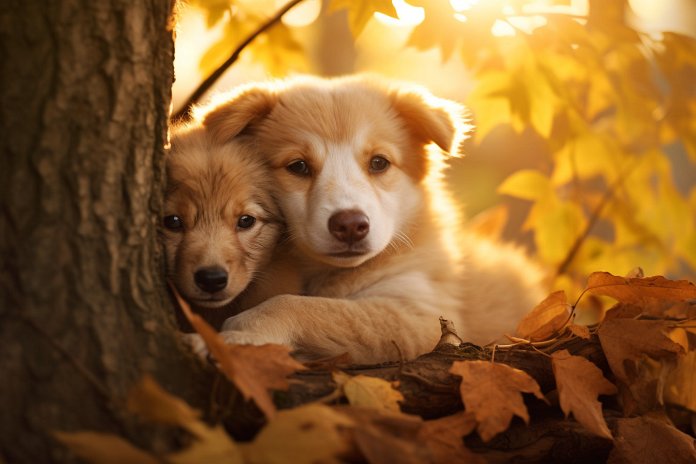
Every May, we take the time to honor and thank our mothers for everything they’ve done for us. But what about the bond between a puppy and its mother? Puppies don’t have much time with their mothers before they are separated, so do they remember them? And if they do, will they still remember them when they become adults? While we can’t be sure what dogs remember, we are constantly learning more about their emotions and cognitive abilities.
Signs a Dog Remembers Their Mother
When reunited with their mother, we can’t really know what a dog is thinking. However, there are physical signs that can indicate a positive and playful experience. A relaxed and approachable dog will have a low tail, tall ears, and a slightly open mouth with the tongue out. An alert dog will have a straight tail, forward ears, wide eyes, and a closed mouth. Play bowing is a fun invitation for another dog to play, with the dog’s hindquarters up and front legs down, tail up and waving, and mouth open with the tongue out.
Body Language
Other signs that your dog remembers a relative or is having fun include a low tail carriage, ears up, tongue hanging, stiff tail, and play bowing. Additional cues include a relaxed posture, leaning forward on their toes, front legs up, and rolling on their back.
The History of Dogs Remembering Their Mothers
Socialization plays a crucial role in a dog’s development, starting with their mother and littermates. The neonatal period, lasting two weeks, is when the pup needs an attentive mother. Puppies are typically weaned between six to nine weeks and continue their social development with litter mate interactions. The development of senses, such as taste, touch, hearing, and smell, also contributes to a pup’s ability to recognize others later in life.
The Science of Dogs Remembering Their Mothers
While some believe that dogs cannot remember their mothers, studies have shown otherwise. Experiments involving separated pups and their mothers’ scents demonstrated that pups preferred their mother’s scent even after two years of separation. This suggests that dogs do remember their mothers through scent recognition.
Training Your Dog to be Social
Socialization is crucial during a puppy’s formative stage, but it’s also important to continue socializing older dogs during their adolescent phase. Introduce your dog to other dogs and people, vary walking routes, and teach them to be comfortable alone. If you’re bringing home an adult dog, their history may be uncertain, but it’s still possible to work on their socialization skills. Take things slow, observe your dog’s behavior, and address any leash training issues before proceeding with off-leash interactions.
“From puppyhood to adulthood, the bond between a dog and their mother is one that can be remembered and cherished.”

Tips & Things to Know
1️⃣ Look for signs of positive interaction: When your dog is engaging with other dogs, look for signs of relaxation and playfulness. These signs include a low tail carriage, ears up, tongue hanging out, and play bowing. These indicate that your dog is enjoying their interactions and having fun.
2️⃣ Pay attention to body language: Dogs communicate through body language, so it’s important to be aware of your dog’s posture and stance when interacting with other dogs. A relaxed posture, leaning forward on their toes, and front legs up are signs of a dog that is comfortable and engaged. On the other hand, a stiff tail, leaning forward with a curled lip, and submissive behaviors like rolling on their back indicate discomfort or fear.
3️⃣ Socialize your dog at an early age: Socialization is crucial for a dog’s development, and it’s best to start during the puppy stage (around three to twenty weeks). However, socialization should continue throughout the dog’s life. Introduce your dog to other dogs and people, vary their walks and routes, and teach them how to be alone. Positive reinforcement and gentle exposure to new experiences will help your dog become well-socialized.
Frequently Asked Questions, Answered ✅
1. Do puppies remember their mothers after they are separated?
– According to studies, puppies can remember their mothers even after being separated. They recognize their mother’s scent and show a preference for it.
2. How can you tell if a dog is enjoying its interactions with other dogs?
– Some signs that a dog is enjoying its interactions with other dogs include a relaxed posture, low tail carriage, ears up, tongue hanging out, and play bowing.
3. What is the optimal period for socializing a dog?
– The optimal period for socializing a dog is during the formative puppy stage, which is typically between three to twenty weeks of age. However, socialization should continue during the adolescent phase of the first year.
4. Can adult dogs still be socialized?
– Yes, adult dogs can still be socialized. It is important to continue introducing them to other dogs and people, varying their walking routes, and teaching them how to be alone.
5. What should you do if your dog prefers to hang out with you instead of interacting with other dogs at the park?
– This behavior is normal for some dogs. If you want your dog to interact with others, start slowly by introducing them to one dog at a time on leashed walks. Watch their behavior and proceed with off-leash exposures only if they are relaxed and not tense. Leash training may also be necessary if your dog is misbehaving on the leash.